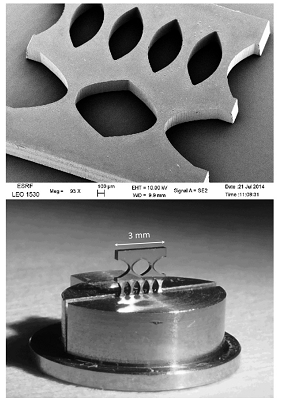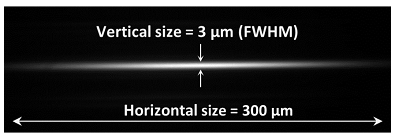Immanuel Kant Baltic Federal University, Kaliningrad, Russia
European Synchrotron Radiation Facility, Grenoble, France
INSTITUTE OF MICROELECTRONICS TECHNOLOGY AND HIGH PURITY MATERIALS of the Russian Academy of Sciences, Chernogolovka, Russia
«Poster report»
OF THE REPORT:
Maxim Polikarpov, Irina Snigireva, John Morse, Vyacheslav Yunkin, Sergey Kuznetsov, Anatoly Snigirev
Maxim Polikarpov
Diamond refractive optics for ultimate storage rings
Since of the end of the 20th century, the intensive development ofX-ray refractive optics’ instrumentation and tools has given birth to X-ray refractive lenses (Snigirev et al., 1996) which have proven themselves as compact; in-line; stable; easy aligned; and coherence-preserving optics for micro- and nano-beam focusing on third-generation synchrotron radiation sources. In view of the global trend of the development of ultimate storage rings (the fourth generation of synchrotron radiation sources), there is a growing need for x-ray optical elements fabricated from materials that can withstand extreme heat and radiation loads while still providing effective focusing. Diamond can satisfy all the requirements provided that a suitable lens manufacturing technology is available.
In our research, for the first time single crystal diamond planar refractive lenses were fabricated by laser micromachining in 300µm thick diamond plates which were grown by chemical vapour deposition. Linear lenses with apertures up to 1mm and radii of the parabola apex up to 500µm were manufactured (fig. 1) and tested at the ESRF ID06 beamline. The uniform intensity of the image of the focused X-ray beam (fig. 2) showed the high quality of the lens’s side walls and profile allowing focusing of the X-radiation down to 3 microns at the radiation’s energy of 7.6 keV.
The present study demonstrated that laser micro-fabrication technology provides a straight forward method for the fabrication of single crystal diamond refractive lenses with large acceptance. The depth of the lenses can be increased by using thicker plates of single-crystal diamond which is commercially available grown by CVD to thicknesses to >1mm, however, the difficulty of precise laser cutting increases rapidly with increasing plate thickness. Planar, single crystal diamond lenses with large depth are capable of withstanding extreme photon flux levels due to their high thermal conductivity and shock resistance; low thermal expansion coefficient; and high temperature stability: they therefore have a great future for X-ray free electron lasers. Diamond should also replace 1D beryllium lenses on ultimate storage rings for refractive lenses placed in the beamline front-end as beam conditioning optics for beam pre-focusing (i.e. collimation) or expanding (Snigirev et al., 1997).
Taking into account the rapid development of laser technologies, femtosecond lasers with high precision guiding systems started to be available for the treatment of diamond which can improve both lens’ surface and shape quality, allowing us proceed to nano-focusing with diamond refractive lenses. The last fact will, clearly, bring diamond optics on the qualitatively new level.

Figure 1. The SEM of the diamond lens, produced by laser-cut technology, top, and the lens mechanically clamped in a holder for the X-ray beamline tests, bottom.

Figure 2.The X-ray image of the focal line produced by diamond compound refractive lens. The horizontal size of the image is 300μm, which corresponds to the relief depth of the diamond plate. The width of the focal line is 3 μm (FWHM), which corresponds to the initial source size of 40μm.
Snigirev, A., Filseth, B., Elleaume, P., Klocke, T., Kohn, V., Lengeler, B., Snigireva, I., Souvorov, A. &Tummler, J. (1997). Proceedings of SPIE 3151, 164-170.
Snigirev, A., Kohn, V., Snigireva, I. &Lengeler, B. (1996). Nature 384, 49-51.
Correspondence to: polikarpov.maxim@mail.ru
Functional Nanomaterials, Immanuel Kant Baltic Federal University, Russia, 236041 Kaliningrad, Nevskogo 14 str.